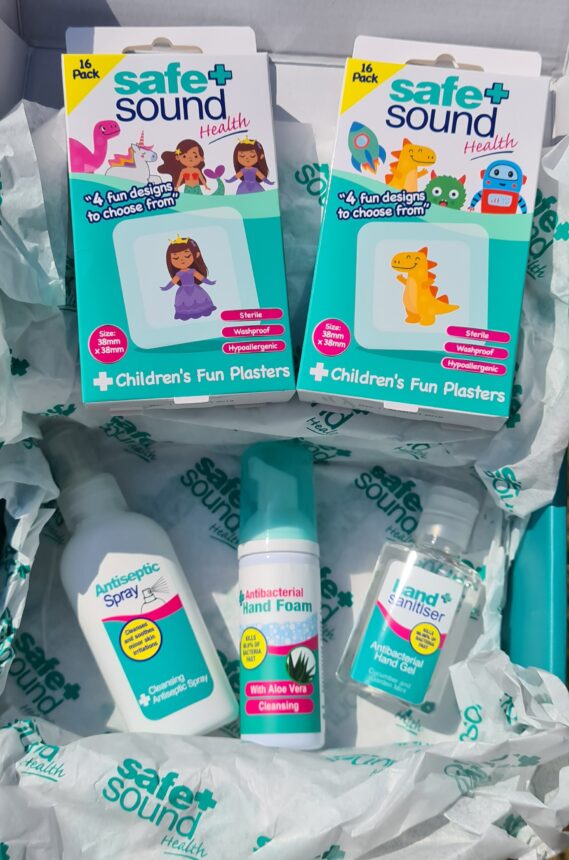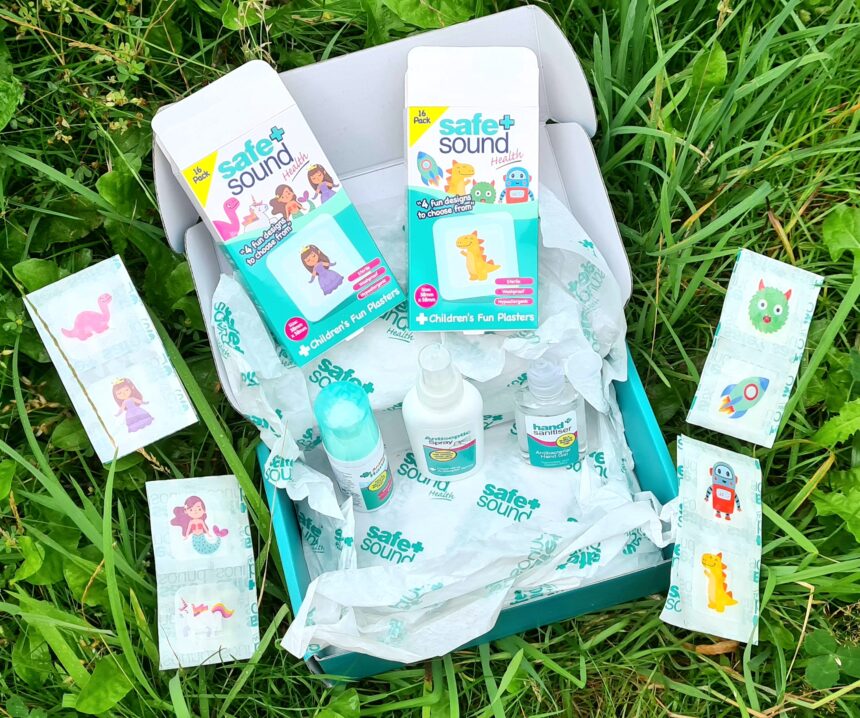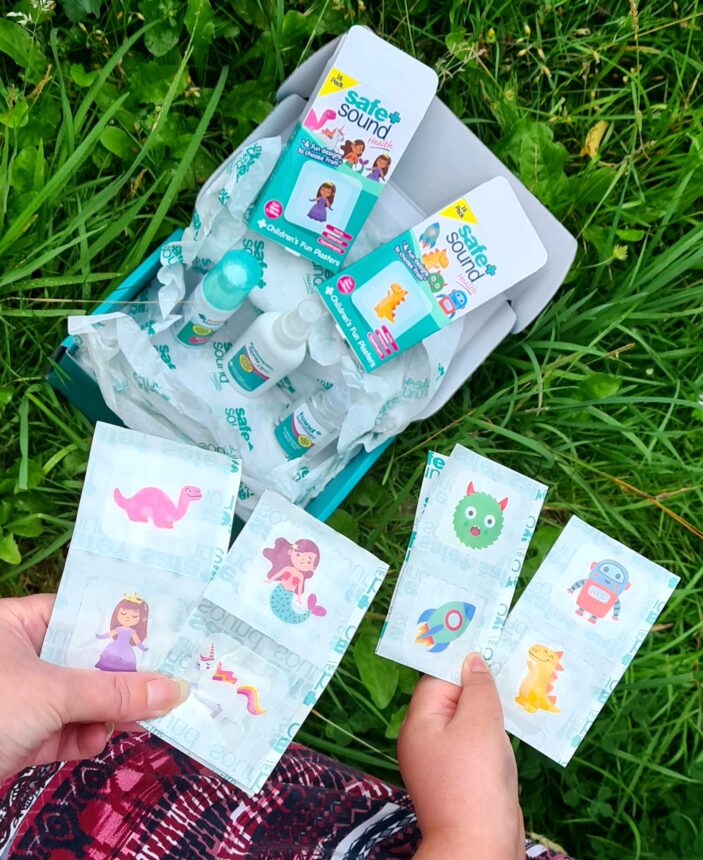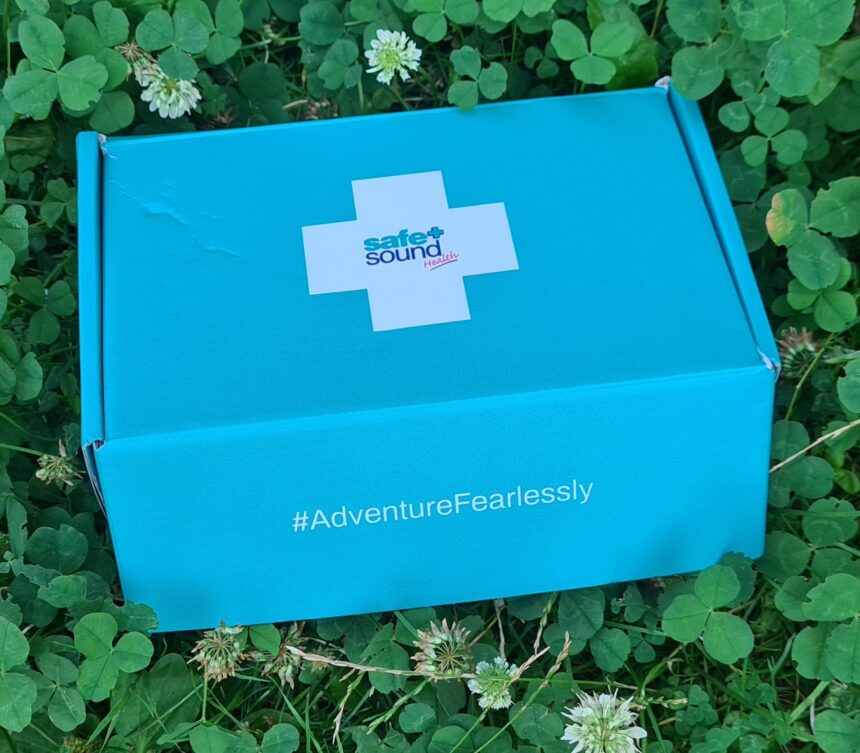*This is a sponsored post in collaboration with Safe and Sound
I am thrilled to be working with Safe and Sound on their #adventurefearlessly campaign; encouraging and celebrating fun outdoor adventures with kids, with the help of their first aid products to easily sort out any little scrapes along the way. One such way to enjoy family adventures outside is cycling. And have bikes have ever been more popular in our lifetime? Probably not! So how do you teach a child to ride a bike?
Well, I won’t pretend to be an expert; Squiggle still hasn’t mastered it herself yet! But I have picked up some useful strategies during our attempts. Above all else, learning to ride a bike should be a fun activity to do together. And of course, actually being able to cycle can lead to lots of exciting outdoor adventures! So, here are some tips…
Prepare for Scrapes and Grazes with Safe and Sound Health First Aid Kit

Safe and Sound Health sent me some fab first aid products as part of their Adventure fearlessly campaign. They are perfect for the ineviteable little grazes and scrapes that happen while developing a new outdoor physical skill, like learning to ride a bike. The range of items they sent include;

Safe and Sound Kids Fun Plasters
These hypoallergenic, flexible, washproof plasters are great for children and are much more gentle on the skin than standard plasters. They come in two funky varieties; kids unicorn plasters (with unicorns, dinosaurs, mermaids and princess designs) and kids dinosaur plasters (with dinosaurs, monsters, robots and spaceships). I am sure these will help kids get straight back on their bike after any minor falls!

Antiseptic Wound Spray
This antiseptic spray is easy and painless to apply and cleans out the wound, helping to prevent infection.
Hand Sanitisers
It is important to ensure hands are kept clean whilst out and about, and even moreso if cleaning a graze. Safe and Sound have a selection of hand sanitisers, including antibacterial hand sanitiser with cucumber and garden mint fragrance, and foaming hand sanitiser that contains aloe vera and Kill’s 99.99% of virus and harmful bacteria.

The Actual Act of Learning to Ride a Bike
The process is difficult for some kids, and easy for others, and there are a lot of things to consider. They maybe in a place developmentally where it’s better to learn with stabilisers, or it maybe helpful to remove the pedal, or begin with a balance bike. The process should be adaptive based on the individual’s needs.
Steering and Braking
Learning to steer and stop will help the learning child to get an understanding of how to control the bike. One way to teach how to brake, is to have them walk to the side of the bike and ask them experiment with the brakes. Talk through what happened after they squeezed suddenly, then use one brake, or the other, or both at the same time. Steering can be practised at the same time.

Scooting and Gliding
With the child sitting on the bike and their legs on the floor, hold the handlebars and walk with them. They should try and walk with as big a step as they can manage or by using both feet to propel forward.
As confidence grows, you can see if they can glide on their own and gradually increase steering into the mix. Once the learning rider is ready, it’s time to practice pedalling.
Pedal Power
Depending on whether or not training wheels are a factor, will affect your approach here. However, before anything, help the child get their footing. You can do this by standing at the front of the bike, your legs clasping the wheel, your hands supporting the handlebars. Ask if they can look at you and find the pedals with their feet. Practice this as much as needed.
The temptation here might be to walk with them, have them pedal along and then let go. However, it can be more helpful to learn from stationary and enable the learning rider to have better control of their speed and momentum.
Ready, Set, Go!
The final piece of the puzzle is taking all the skills learned and putting them together. There are any number of ways to do this. Of course, the point here is that they need to be able to ride from stationary and stop again. You can opt to keep hold of the bike, or not, depending on what the child is most comfortable with. Eventually, they should get a feel for it and things progress naturally from there.
Practice Cycling
Learning to ride is a process that requires practice and patience to progress. Sometimes, it will be necessary to go back a step and spend a little more time getting pedalling or balancing right. Do things in a way that works for you and your child.

Happy cycling!


These are all great tips, perhaps I should use them with my 30-year-old partner who doesn’t know how to ride a bike!! A first-aid kit is definitely a must, I have a vivid memory of my little brother being rushed to A&E after riding his bike into a wall. Thankfully he didn’t need stitches, but he’s got a pretty nasty scar.
My son Theo learnt to ride his bike at about 3 and now absolutely adores flying up and down mountain bike tracks, however my other two kids have yet to master it and its definitely something I want to work on with them.
My son is only one so a bit young yet but I’ll definitely be stocking up on those plasters!
Alessia still is a little unsure when riding a bike and is so scared of falling . I think these plasters at hand she wouldn’t mind the fall 🙂
We have been getting our kids to ride their bikes more during the summer holidays and this First Aid Kit from Safe and Sound is something we need to get as well for the ‘just in case’ accident moments. I am glad they do include hand sanitisers as well as it is so important to keep hands clean
I can still remember how happy I felt when I finally learnt how to ride my bike without stabilisers.
I’m going to hold my hands up and admit that I never learned how to ride a bike, and as an adult the idea of falling off and hurting myself is too scary. Kids are a bit more fearless even if they hurt themselves x
We really need to get my youngest riding his bike, this looks like a great way to be prepared, I love those plasters!
These plasters etc look great, such a great idea and great way for something a bit funky for the kids, i know my youngest would love it.
Always good to be prepared with the essentials – once they are patched up its time for the off again – love a childs mindset
There are some great tips here for sure, I am sure parents will find this information really useful. Happy cycling x
My grandson is still learning to ride his bike and I am excited for that day when he can do without the stabilizers. It would be so much fun to go bike riding together with him. Those safe and sound plasters are really cute. A first aid kit is must for every parent to take along. I will also recommend these plasters to my friend who is a pediatrician. She can use this to apply to her patients’ arm after they had their shots.
So many great tips! Our daughter Mary doesn’t know how to ride a bike yet and she is 12
These sound like some great tips! I remember not long after I had my stabilizers off I went crashing down and badly scraped my knees, so having a first aid kit to hand is a must!
Is it really bad that I want to fall over just so I can use one of these plasters?? They are so cute! My kids would be constantly finding a reason to need one, I’d have to buy more each week!
As for learning to ride a bike, my neighbour has managed to teach every child in the street to ride a bike from the age of 3 upwards, I have no idea how she does it, she is magic! I have never seen anything like it, nervous children, terrified to even sit on the bike are racing round the block in an hour!